Beef Rendang or rendang daging, in Malay/Indonesian, is a curry fit for a King. It’s a curry with meltingly tender beef that’s been slow cooked in a rich, aromatic and highly spiced coconut gravy that will keep you coming back for more. And more!
Estimated reading time: 8 minutes
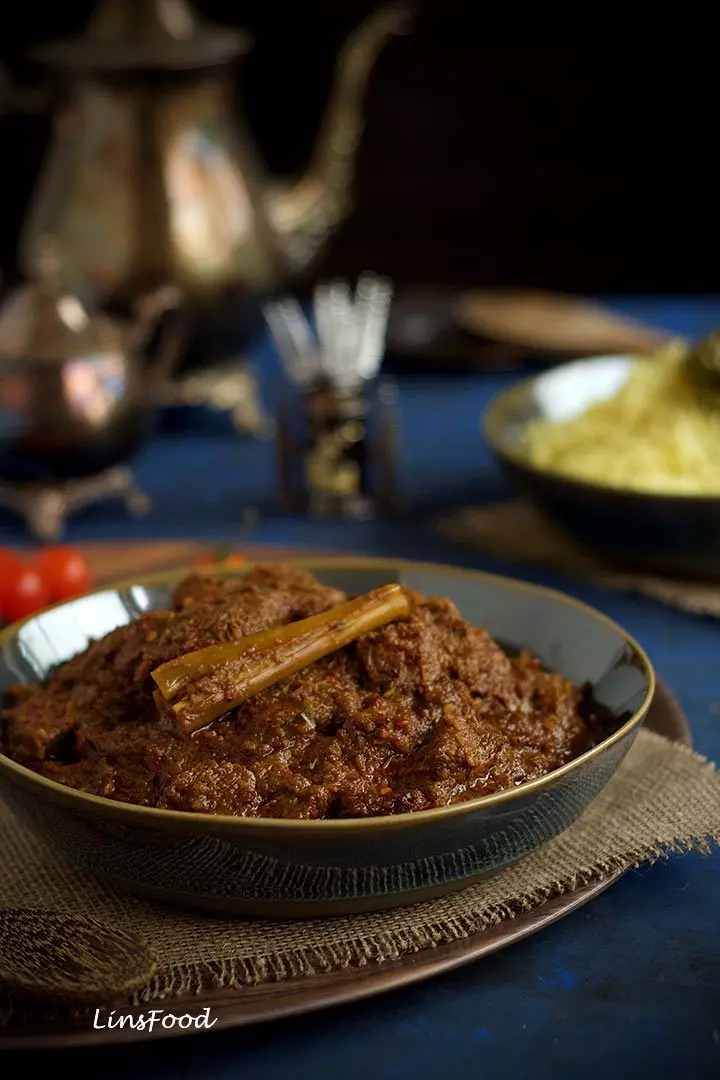
Where does Beef Rendang come From?
Originally from Indonesia, going as far back as the 15th century, beef rendang started out life very humbly; it was a method to cook down and preserve tough buffalo meat, the privilege of the rich in the villages of West Sumatra, Indonesia, where it is said to have originated.
The buffalo meat rendang daging would be packed in banana leaves and taken on the frequent long, arduous journeys that many workers would embark on, in their quest for new jobs in nearby cities and villages. It would keep up to 4 weeks, apparently.
But beef rendang has long been adopted and considered a local dish by the Malays in Singapore and Malaysia.
Traditionally, no Malay wedding is complete without beef rendang, or rendang daging (daging = meat) as we would call it in Malay, just as no Hari Raya (Eid) table is quite right without this most regal of dishes. Mine certainly isn’t!
At Christmas, we can’t do without a homemade Christmas pudding, at Eid, we can’t do without beef rendang!
What Makes Beef Rendang so Special?
In my opinion, it’s the combination of spices and aromatics and the low and slow cooking. Galangal, ginger, lemongrass – these 3 aromatics alone are enough to spike any recipe. But add to that, we have coconut milk as well as the toasty and caramel-like kerisik (dry toasted coconut).
The result is a creamy, yet full-bodied, potent, and highly perfumed dish that will enslave you from your very first mouthful.
Nay, from your very first sniff!
Beef Rendang Recipe
So many of my childhood recipes had their beginnings in my granny’s kitchen. However, this beef rendang recipe (resepi rendang daging) belongs firmly with my mother. She was a nurse until she retired, and was also a well known recording artist in her late teens and 20s.
She and my late uncle were popular for the Malay songs they used to sing. Many of those songs were Malay renditions of popular Hindi songs with my uncle doing the translating.
Got a Malay background? Ask your older family members if they know the late Zainab Majid and her brother, the late Razak Majid. That’s mum and my uncle.
I have distinct memories of cooking this with her when it was just the two of us in our apartment (our family was always all over the place!).

The method of cooking this beef rendang is something she learnt from her aunt in Ipoh, Perak (Malaysia), where the popular royal Rendang Tok is said to have originated.
- Basically, in our recipe, there’s no initial sautéeing involved.
- We just place everything into a saucepan or a Dutch oven, and let it cook away on low heat for a good 2 1/2 to 3 hours.
- At 3 hours, you will have meat that’s practically falling apart, which is the hallmark of a good beef rendang.
- You can also stop cooking earlier, as long as the meat is cooked, for a wetter curry.
That is another thing about beef rendang – to each his own is carried to another level with this curry, while still respecting the boundaries.
Beef Rendang Ingredients
Some dishes just call for difficult to find ingredients that you cannot substitute for and hope to recreate the same dish. And this is one of them.
Some of the links below for the ingredients are still on LinsFood.com. It will take me the whole of 2021 to move everything over!
Galangal (lengkuas in Malay)
Click to read more on galangal. The curry won’t work as well without it, I’m afraid.
Galangal has a sharp, floral, sweet and almost piney aroma and flavour. It is a different ingredient altogether from ginger, in terms of uses. Ginger is citrusy and spicy. So these 2 are not interchangeable. No matter what you may read on other food sites.
The good news is, in the UK, galangal paste is easy to come by; it’s sold in larger supermarkets like Waitrose and Sainbury’s.
1 tsp paste = 1″/2.5cm fresh galangal.
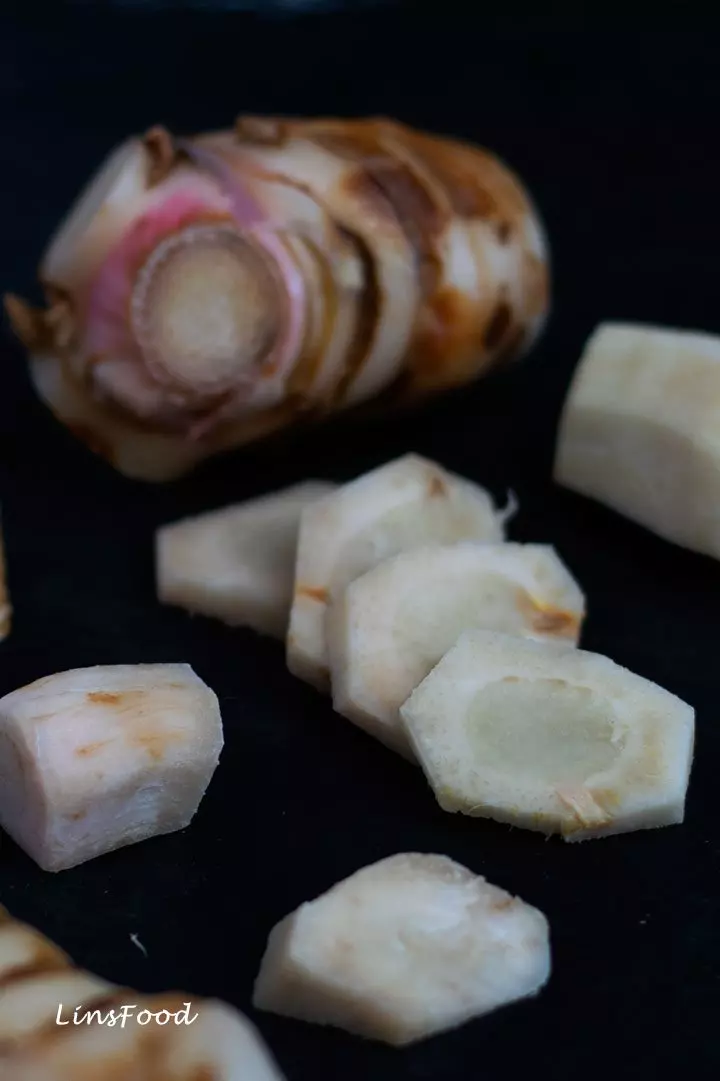
Kerisik
Click here to read more on Kerisik, on LInsFood. As mentioned above, this is just diy dry roasted/toasted desiccated coconut. However, be sure to get desiccated coconut without any sugar added, and ideally, no preservatives.
I will show you how to do this in the video below. All you need is 4 Tbsp of fresh grated coconut or desiccated coconut, and follow the video.
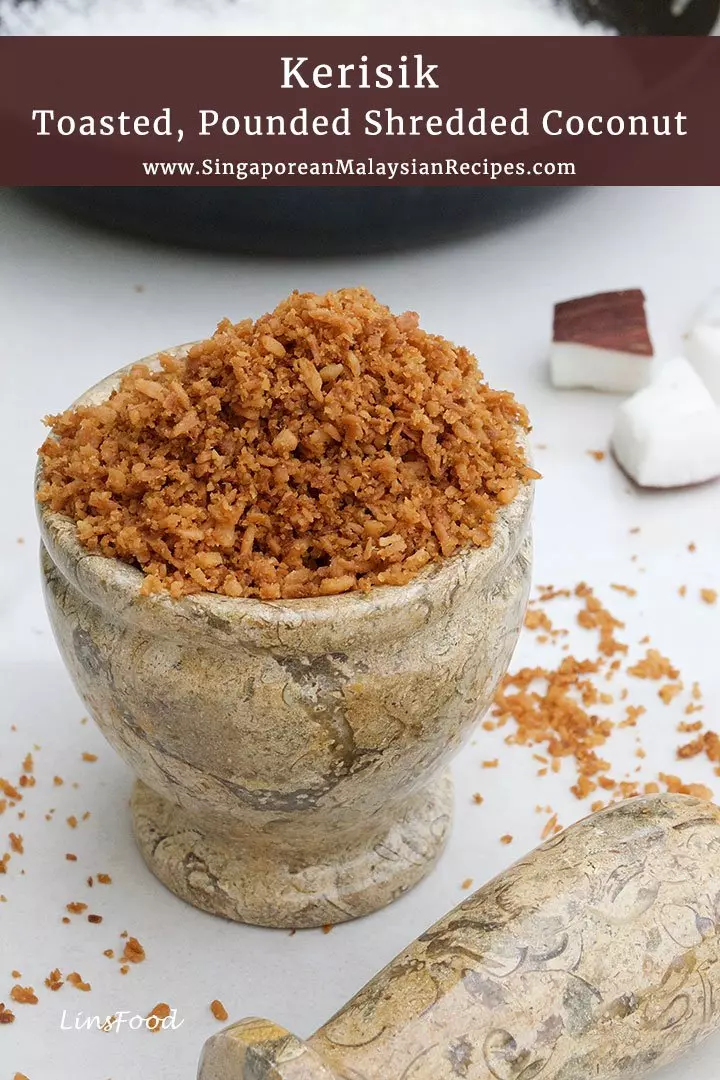
Turmeric Leaves (daun kunyit in Malay)
Click here to read more about turmeric leaves and how to grow them. Turmeric leaves have a grassy and citrusy constitution that is the defining aroma of an authentic Singaporean and Malaysian beef rendang.
Outside of Asia, they are probably not easy to come by but the good news is, if you have access to fresh turmeric, then you can grow them yourself! As long as the weather is warm.
Just pot up a fresh tuber in compost and keep somewhere bright and mild, like a windowsill. In fact, even in the cold of winter, if you leave turmeric tubers long enough in the kitchen, they will produce shoots.
Kaffir lime leaves are not a substitute for turmeric leaves but they are an acceptable alternative, if you cannot get hold of turmeric leaves.
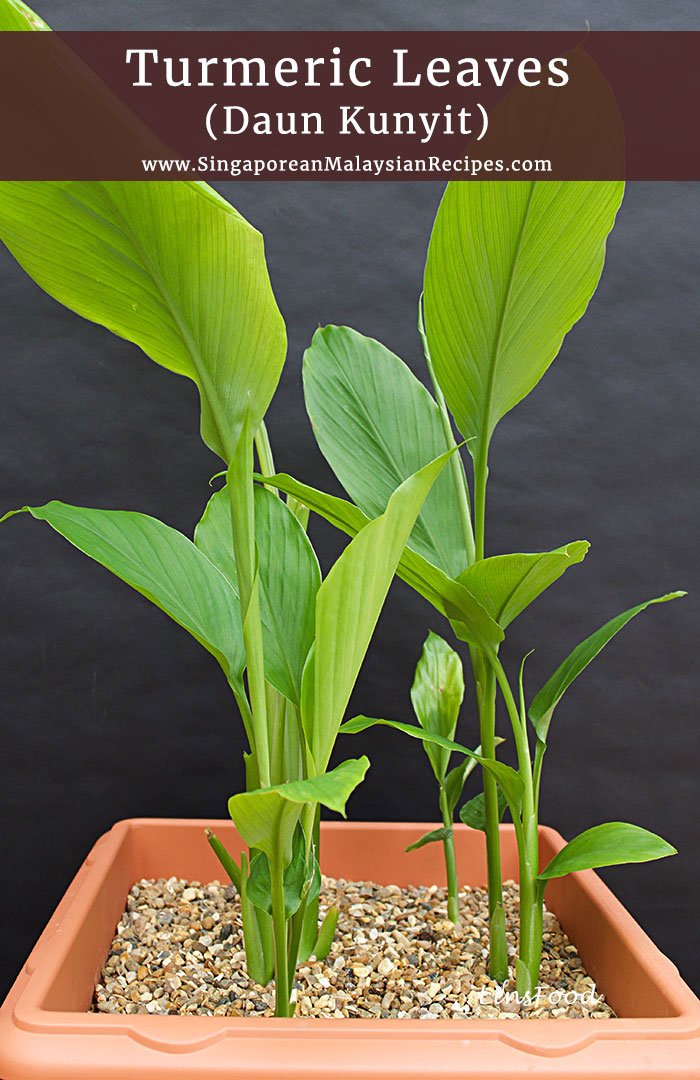
Chillies (chili peppers)
This is traditionally a spicy curry. But you can cut those dried red chillies right down for a milder version. I always make 2 separate lots, one a fairly spicy version, the other, a very mild one, for the younger kids.
Speaking of ingredients, beef rendang offers some latitude in the spices that you can use to cook it.
Some cooks will make it more curry-ish, adding cumin and cinnamon to the mix. Others leave all these spices out, no coriander and turmeric either, as in my recipe here.
And there are plenty of folks who add tamarind (asam) to their beef rendang for just that bit of sour and some will add gula melaka, or palm sugar for an extra hint of caramel, along with the kerisik. I must confess, that I chop and change sometimes too!
Ground Ingredients in Beef Rendang
You do need a chopper or blender for this to work best. Add the ingredients in the order that they’ve been listed, giving the earlier ingredients (the more fibrous ones) a better opportunity to be ground to a finer stage.
Coconut Milk – always cook on a low heat when cooking with coconut milk. Otherwise, your milk will split, even the canned variety with stabilisers can be temperamental sometimes.
Can you use other meat to make Rendang?
Absolutely, just substitute it, pound for pound. In fact, chicken rendang, or rendang ayam is also a very traditional dish in these countries.
When cooking chicken rendang (click for recipe), you want to use meat on the bone for a tastier curry.
And, if you know someone who’s vegetarian, I have a Vegan Rendang recipe for them too. Just click here to get the recipe.
Edit 2024: This article was first published on LinsFood years ago. Since then, my kids have all gone vegetarian (1 pescatarian). So I make them rendang with vegan protein pieces, using this exact recipe.


How to Serve Beef Rendang
Given that it is a very rich curry, whatever accompaniments you have will lean towards, erm, lean.
- Nasi minyak, which is the Malay equivalent of pilau rice, is a very traditional accompaniment to beef rendang.
- Plain steamed rice or flatbreads, are also another great way to serve this beef rendang.
- Another starch that is popular with rendang daging is Roti Jala, a lacy pancake that is simplicity itself and that I’ve been meaning to blog for a long, long time. My sister in law even got me the contraption to make it the last time they visited from Singapore, about 3 years ago! So, again, watch this space.
- Lemang is the perfect recipe for to go with our Beef Rendang! Lemang is glutinous rice that’s traditionally cooked in banana leaf lined bamboo poles. While in Malaysian and Indonesian villages, families may cook it themselves, it has long been something most folks buy at food stalls, and especially night markets.
The recipe here is my version of it, without using the impossible-to-get bamboo poles for cooking! For all of us who no longer live in the countries we were born in. - And remember the pachri nenas from a few weeks back? The pineapple salsa? That will go so well with beef rendang, as an accompaniment.


And on that note, shall we get our aprons on?
♥ If you like the recipe and article, don’t forget to leave me a comment and that all important, 5-star rating! Terima kasih! ♥
And if you make the recipe, share it on any platform and tag me @azlinbloor, and hashtag it #linsfood
Lin xx

Beef Rendang Recipe (Resepi Rendang Daging)
Equipment
- knife
- scissors
- ladles and spoons
- sieve/colander
- bowl
- saucepan or dutch oven
Ingredients
Ingredients A
- 1 kg generous cuts of braising or stewing beef
- 400 ml coconut milk
- 250 ml water
- 1 stalk lemongrass, bruised (serail)
- 2 large turmeric leaves OR 6 kaffir lime leaves (daun kunyit)
- 1 tsp salt
Ingredients B (to be ground)
- 3 stalks lemongrass (serai)
- 2.5 cm galangal (lengkuas)
- 5 cm ginger (halia)
- 5 medium cloves garlic (bawang putih)
- 20 – 30 dried red chillies (cili kering)
- 2 large onions, quartered (bawang besar)
- 4 Tbsp kerisik you'll want 4 Tbsp of grated or desiccated coconut, watch the video on how to make it.
- ½ tsp ground turmeric (serbuk kunyit)
- 1 Tbsp ground coriander (serbuk ketumbar)
Instructions
Let's prepare the ingredients
- Cut the dried red chillies in 2-3 pieces, depending on their lengths, and soak them in a bowl of hot water for 20 minutes. In the meantime, get all the other ingredients ready.
- Roll your turmeric leaves up and either using a knife or a pair of scissors, cut them up into thin shreds. If using lime leaves, just tear the leaves up.
- Drain and rinse the chillies, and losing the seeds, if you like. Place them aside.
Let's chop up the ingredients into a paste
- Start chopping your ingredients in the order that they are listed in the above list. Start with lemongrass, chop for 10 seconds, then galangal, chop for another 10 seconds, then ginger, then garlic, and so on. Everytime the chopped ingredients start to feel a bit dry, add a quarter of an onion for moisture. No need for water. Continue chopping/blending until you have a fairly fine mix.
Let's get cooking!
- Now get a large saucepan or a dutch oven and place everying in, start with the beef, then the ground ingredients, the coconut milk, kerisik, salt, lemongrass and finally the thinly shredded turmeric leaves or your torn lime leaves.
- Put it on a low heat and let it come to a gentle simmer. Stir to mix everything up, and leave, uncovered, to cook for a minimum of 2 and a half hours to 3, until the beef is meltingly tender and you have a dry-ish curry.
- You shouldn't really need to stir the rendang until the last 30 minutes or so, where you'll have to do it a handful of times, as it starts to dry up and may start to catch on the base. Check seasoning and add more salt if you think it needs it.
- Serve as suggested above. The beef rendang will keep, covered, for a week in the fridge. It also freezes well, although the beef will be falling apart even more after freezing.

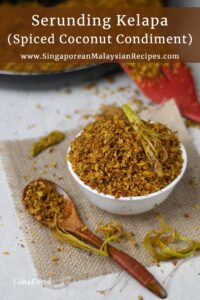
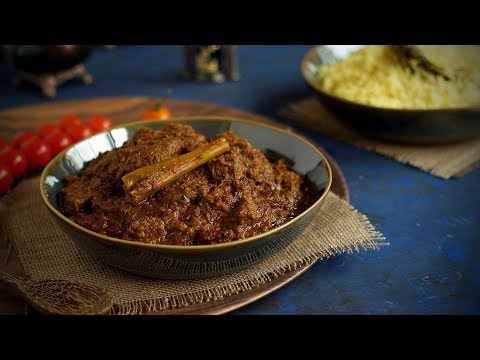
You mention kerisik in the lead up to the but don’t include the quantity to be used in the ingredients.
Hi Charles, it’s in the Ingredients B (to be ground) list – 4 Tbsp. Third from the bottom.
Hi Azlin! Can you advise as to when the kerisik needs to be added in to the rendang?
Hi Jamie, in Step 1 of “Let’s get cooking”, where it says add everything, starting with… .
I’ve now added kerisik to the few ingredients I listed as examples, to ensure it’s clear.
Hi! Thanks for sharing your recipe. May I check however, my rendang doesn’t reduce like yours in the video after 3 hours. At the 3-4 hour mark I still have a lot of liquids in the pot and it’s still bubbling away. To reduce it, I increase the heat and then the rempah (spices) gets stuck to the bottom of my Dutch oven. Not sure why. Do you have any advice for me?
Thanks!
Hi Pek, that’s unusual. Did you leave it covered when you were simmering it? That’s the only reason the liquid wouldn’t have evaporated as much.
And definitely Dutch oven, not a slow cooker, right? Slow cookers want much less liquid.
Also, correct amount of liquid (in case you halved the recipe)?
My best advice to reduce the liquid further without overcooking the meat:
Take as much of the meat out as possible. Then increase the heat to medium and cook the curry off for about 5 minutes, stirring regularly, until it’s drier.
If you are using fresh coconut milk (as opposed to canned), careful with the heat as it will split if the heat is too high.
I hope this helps.
Hi! I can’t wait to try this. If I use a slow cooker, do I need to adapt the method or cooking time, as I need to keep the lid on? Thank you!
Hi Tony, rendang is perfect for slow cooking. I don’t own a slow cooker but I think the going advice is to reduce the liquid in a recipe by a third.
So I’m thinking use the same amount of coconut milk but maybe reduce the water to 100ml? Or whatever ratio if you’re cooking a different amount.
A wetter end result is preferable to a dry one.
I hope that helps/works.
Let me know how it goes.
Hello, thank you for the recipe. I just made it and it was delicious. I do have a question. The recipe I had been using uses tamarind. May I know why this recipe does not use this pls?
Thanks
Guhan
Hi Guhan, I’m pleased that you loved this beef rendang recipe. Every family has its own version of beef rendang. Mine has never used tamarind because it doesn’t really need it. Some people will even use more curry spices in theirs, you might have noticed, like cinnamon, cumin and so on.
Traditional beef rendang doesn’t really want all these additions. Its beauty lies in the aromatic combination of a few things like the ginger, lemongrass, galangal, turmeric and coconut. Once you start adding all the other ingredients, then it loses that uniqueness and begins to resemble Thai, Indian and other Malay curries, if that makes sense.
So that’s the reason I don’t use tamarind, and also because it’s the recipe I grew up eating and cooking, and I’ve never tasted a better one!
I’ve made this recipe so many many times, finally leaving a comment! The best beef rendang recipe ever! Over the years I’ve tried quite a few but I keep coming back to yours, for the flavour and how easy you’ve made it to understand. I guess some traditional recipes you just have to be local to get it right! Thanks Lin.
Hey Nicola, always great to hear from you. I’m so pleased to hear that you love our beef rendang recipe and thank you for leaving a lovely comment.
Thank you, this was amazing, just the way my Malaysian granny used to make. Perfect amount of spice.
Awesome, thanks for letting me know!
This is an amazing recipe! Super easy to follow and turned out really tasty! Thanks a bunch for sharing your mum’s recipe!
My pleasure, Allysa, I’m pleased you enjoyed it.
This was incredibly delicious, everyone loved it. Thank you!
My pleasure, Ann.
Azlin, can I freeze this? Thanks.
Hi Athena, yes you can, for up to a month.
I have to agree with that last comment – this is the best beef rendang I’ve ever had and cooked! Thank you Azlin.
My pleasure, Luc. Always good to hear from you.
The best beef rendang recipe I’ve ever had, hands down! And you are amazing to watch and listen to on video. Thank you for all that you do for us misplaced Singaporeans.
Hey Mo, thank you so much for your very kind words. I’m pleased you think this is the best rendang you’ve had – high praise indeed! And it is my pleasure.
My step-grandmother is Malaysian and her curry is out of this world good… I crave it regularly – however, we now live in different countries and she will not share the recipe with a soul. This recipe is SO good and pretty similar to hers… My partner is also obsessed. Ultimate indulgence with some fresh roti canai! Heaven!
Hi Ally, I’m so pleased that I could help you with this recipe. What you said brings back something my late granny told me when I was little in Singapore.
When she was a young bride having just moved from Malaysia to Singapore, sometime in the mid 20th century, she had a few neighbours who would guard their recipes zealously. She made a promise to herself early on that she would never do that, and all her life, went out of her way to share her recipes, with all and sundry. And that’s something that’s always stuck with me. And even before I started my first food blog some 10+ years ago, I’ve always done the same.
Hi can you tell me how to make this with chicken? Thx
Hi Rosey, just follow the recipe exactly, and use 1 kg chicken portions (some meat on the bone for a tastier curry). The curry will serve about 6 people.
It’s cooking away now, the house smells just wow! Going to make your pilau rice to go with it. Thanks!
Very nice, let me know what you think!
I just love this rendang recipe, it has been the one I’ve been making for years since I first saw it on your other blog. I make chicken rendang using this recipe too so thank you!
That’s awesome, Anne, really pleased to hear it!
Hands down the best beef rendang recipe I’ve had. But then all your recipes that I’ve tried have been keepers. I remember that Indian Jewish curry, I make that regularly as everyone loves it. Thanks again!
Thank you so much, Roslynna, always a pleasure to know how much one of my recipes is enjoyed.
Surprised not to see any star anise but overall decent recipe. Only thing I add is star anise, candlenuts and turmeric root
Hi Daniel, rendang, as I explain in the post, is a very, very personal recipe. Each family and region will have its own version. This was my mum’s via a grand auntie in Ipoh, Malaysia. Thanks for dropping me a comment.
Totally delicious, everyone loved it! Have you got chicken rendang recipe?
Can I use fresh red chillies if I can’t get dried?
Hi Putri, sure you can. Just add them as in the dried chillies. The flavour of fresh chillies won’t be as deep, but your rendang will still be delicious. You could add a 1/4 tsp pf dried chilli powder (mild or hot), to mimic that depth. No more, as you don’t want any bitterness to carry over.
Such an amazing rendang this, the best one I’ve ever cooked. Thanks Lin.
My pleasure, Jamal, I’m pleased you loved it.
The best! I’ve made this recipe 5 times now, and it has turned out delicious every single time. Thank you!
Awesome, thanks for letting me know, Tiffany. So pleased to hear you love it.
Amazing recipe! I impressed my friends with getting them to try, thank you for your recipe.
I’m really pleased to hear that, thanks for letting me know!
Thank you Kak Lin, just like my mother used to make.
You are very welcome, Nazlin, I’m really pleased to hear that.
I think this was the best rendang I’ve ever tried. I really loved the method of not sauteing anything at the start. Planning to make it for a potluck this weekend. Thank you for sharing your mum’s recipe with us.
It’s my pleasure, Linda. I’m pleased that you love it.
Hello, was looking to try this… just wondering.. do you put any oil in? If so how much?
Hi Dalvin, no I don’t add any oil to sauté the rendang paste. We place everything in the saucepan and let it come to a simmer. On the video, this starts at around 7:10.
This is a recipe that’s been handed down a couple of generations.
But in my vegan rendang recipe, I do fry the spices with some oil.
Loved it! Couldnt find the right chili in my supermarket but was very good anyway!
Next time im going to search in our asian food store, (I live in Sweden) But thanks for a great recepie!
Hi Ingela, I’m very pleased to hear that! It’s always a pleasure when someone enjoys a recipe from my blogs. x
Oh man, this was possibly the best curry I’ve ever tasted! Never had a curry from that part of the world. Amazing!
I’m pleased you enjoyed it, Harry.
Spectacular recipe! Thanks!
A pleasure, Charles.
Thanks Kak Lin, simply amazing. I’m hosting the family at Raya this year insha’allah, so wanted to do a test run. It was so good. Going to try your kuih tart too.
A pleasure, Su, I’m pleased you enjoyed it!
One of the best curries I’ve ever had. Thanks looking forward to trying more recipes here.
A pleasure, Diane, it really is one of the best curries!
Absolutely delicious! My children loved it too and they are fussy. Thank you, it was so easy to make too, something I didn’t realise before. And best part, I froze the leftover for another day.
Cool, Angeline, I’m pleased everyone enjoyed it. And yes, to rendang leftovers!
Made this for dinner last night, it was out of this world. Can’t believe I just cooked a delicious rendang at home, better than anything I’ve had at restaurants! Thanks!
Haha, a pleasure Mark. Once you have the ingredients ready, it’s pretty easy.